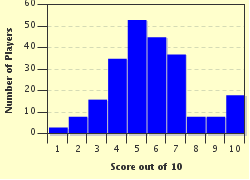Quiz Answer Key and Fun Facts
1. What was the cause of the War?
2. How did the war start?
3. The Battle of Stoney Creek is regarded as the turning point of the War in Upper Canada. What was the outcome?
4. The New England states opposed the War and continued to trade with Britain during the conflict.
5. According to the US Navy, which naval duel of 1 June 1813, "... provided another of the War of 1812's many convincing examples of the vital importance of superior training and discipline in combat on sea and land."?
6. What was the only large territory captured AND held by either side at the conclusion of the war?
7. British forces captured Washington DC causing the US government to flee the capital.
8. During the Battle of Baltimore, Francis Scott Key wrote 'The Star Spangled Banner', which President Madison adopted at the US National Anthem.
9. What was the final battle fought in the War?
10. What was the outcome of the War?
Source: Author
dericpw
This quiz was reviewed by FunTrivia editor
bloomsby before going online.
Any errors found in FunTrivia content are routinely corrected through our feedback system.

